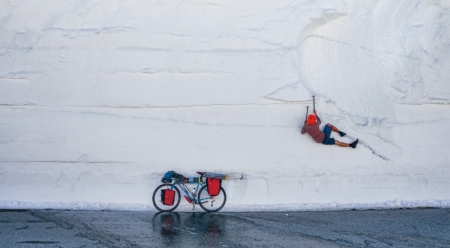“The Last Hill:” A Film About Getting There Slowly
We were off-the-couch bikers, versed in miles per hour, not miles per day.
After seven days of biking to ski, we needed a rest day. Hot springs mandatory. We remembered a shortcut to the Green Church pools, which was 9 miles shorter than the highway route. Shortcuts—with deeply rutted, washboard dirt roads on bicycles loaded with ski and camp equipment and food—aren’t always shortcuts.
Our rest day turned into a seven-hour ride.
We made it to the hot springs by sundown, but the promise of healing waters was disrupted by tubs full of people, whose fast cars had conquered our steel steads. We found rest next to a Subaru named “Bill Murray” and started eating—for the days now behind us and ahead.
We wanted to see the simple scenery that not many see—the saddle vista. I wanted to reapproach my approach to skiing. Gear, gears, grub, water and the will to keep pedaling, instead of packing the car and driving to the trailhead. We started on bikes from Reno, Nevada, and pedaled to the base of the Sierra, loaded down with ski and snowboard gear, ready to summit peaks and rip lines under our own power. We biked through winds that knocked us around, up hills that would never end, on roads that shook us; and we skied ice, corn and everything in between. We made it all the way to the top of Mount Whitney—the tallest peak in the lower 48 states.
We were so tired that other skiers beat us to the summits and skied the lines we were headed to. Embarrassing at first, this became a point of pride, as we acknowledged the reason behind our heavy-legged exhaustion—hundreds of miles on the bike. We began marking each ski run as a first descent, because the approach started at my house (and I was pretty sure that no one else had biked to the Eastern Sierra from there). Biking had slowed us down, dulled our competitive spirits, and allowed us to laugh at ourselves as we struggled through delirium and fatigue to perform what for many of us is a daily routine: climbing uphill to ski down.
Biking to experience a place from a different, slower perspective isn’t new. But by the end of our Sierra saddle time, we understood what others before us have likely discovered: The bike makes you tired in the short term, but rejuvenated over time.
This story first appeared in the November 2017 Patagonia catalog.

